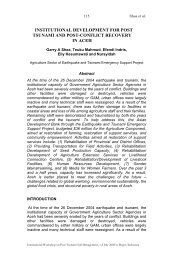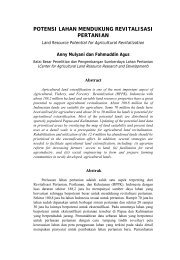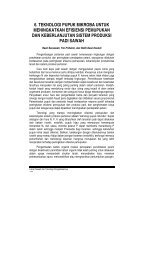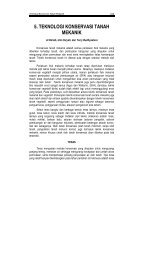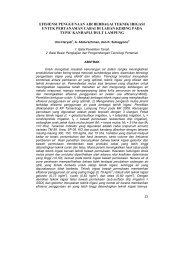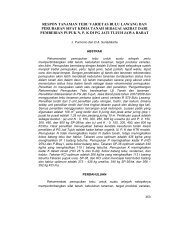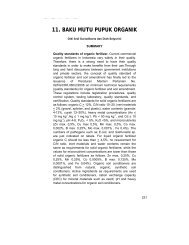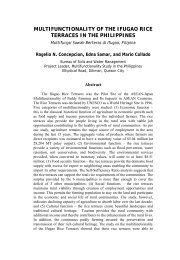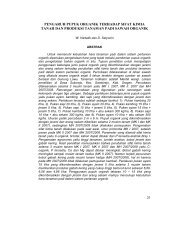Proceedings - Balai Penelitian Tanah
Proceedings - Balai Penelitian Tanah
Proceedings - Balai Penelitian Tanah
You also want an ePaper? Increase the reach of your titles
YUMPU automatically turns print PDFs into web optimized ePapers that Google loves.
135<br />
McLeod et al.<br />
fields after the tsunami. When the surface drainage systems were<br />
damaged by the tsunami, both the vertical and horizontal leaching of<br />
salts was restricted. On the other hand, the coarser soil in dryland<br />
fields is more permeable, hence more conducive to leaching.<br />
Figure 3. Areas that were flooded for a longer period are more saline,<br />
EM38 data from Lho Nga in August 2005 (left) and from a<br />
cluster of sites in Pidie District in October 2005 (right)<br />
In rice fields, good irrigation, water availability and water circulation<br />
affected the level and persistence of soil salinity problems. Rice fields<br />
that were under irrigation at the time of the tsunami event tended to be<br />
less saline than those fields that were dry. This suggests that<br />
seawater did not infiltrate into the already flooded soil, but most likely<br />
moved horizontally at the soil surface.<br />
The availability of fresh irrigation water and good drainage systems<br />
continued to be important after the tsunami. Both transects in site 5<br />
(Figure 3) were flooded with seawater for more than three days after<br />
the tsunami. The owner of the paddock in site 5-2 was able to pump<br />
the saline water out while the farmer in site 5-1 could not. A good rice<br />
crop was observed in transect 5-2 in October 2005, while the crops in<br />
site 5-1 all died. However, after irrigation water became available in<br />
2008 both sites had good rice crops.<br />
In some areas, agricultural lands have been exposed to tidal<br />
movements due to the loss of sand dunes. These areas will remain<br />
saline and unsuitable for normal cropping until new sand dunes or<br />
other protection from sea water is in place.<br />
CONCLUSION<br />
Electromagnetic induction technology, using the EM38 equipment has<br />
allowed rapid assessment of soil salinity in tsunami affected areas in<br />
Aceh. It allows monitoring of saline sites over time to assess their<br />
suitability for cropping after a tsunami.<br />
International Workshop on Post Tsunami Soil Management, 1-2 July 2008 in Bogor, Indonesia



